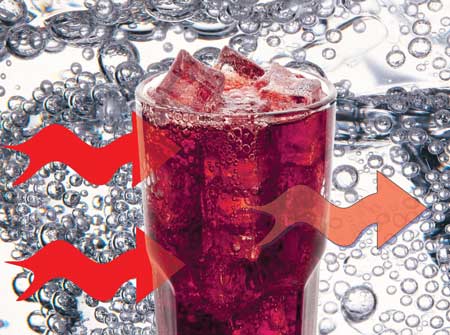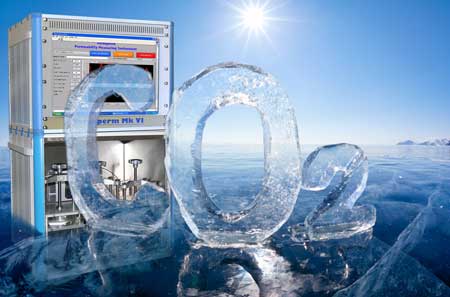

 The flavour of the a fizzy drink changes between a bottle and a drinks can, and their shelf lives are different as well. Surprisingly, these two characteristics both arise from the container's permeability CO2 vapour permeability.
The flavour of the a fizzy drink changes between a bottle and a drinks can, and their shelf lives are different as well. Surprisingly, these two characteristics both arise from the container's permeability CO2 vapour permeability.
Both flavour and shelf-life problems are caused because carbon dioxide permeates out through the material sides of the plastic bottle, the cap and the can, but It does this at different rates. Within twelve weeks, a plastic bottle can lose up to 15 percent of its carbon dioxide fizz!
Although the science behind this is "challenging", Versaperm has a simple solution that helps manufacturers deal with it.
Vapour permeability is the ability of a gas or vapour to flow through a solid material. With fizzy drinks it is-the outflow of CO2 combined with the inflow of oxygen. And if you consider fruit juices or beer-the story gets very complex indeed – with different and competing factors affecting many aspects of flavour, preservation and fizz.
Typical levels of carbonation
|
Volume |
g/l |
Lightly sparkling |
2.0 |
4 |
Carbonated fruit juice |
2.5 |
5 |
Lemonade |
3.0-3.5 |
6-7 |
Cola |
4.0 |
8 |
Mixer |
4.5-5.0 |
9-10 |
It is simple to understand in principles involved – you just need to know the rate at which a vapours such as CO2, Oxygen. water-vapour and nitrogen) flow in or out of the bottle through its sides. However, their are critical complications - the rates for different gases can be wildly different (e.g. PET is a good water vapour barrier but poor for oxygen). For nitrogen and other vapours, the barrier properties are different again. Then comes temperature and pressure which can have a somewhat non-linear effect, so a change of 45oC changes the permeation of oxygen through PET by a massive 2500% (at 50% RH).
And for drinks such as fruit juices, beer, tea, and sparkling water which all rely on different and sometimes competing factors to maintain their freshness, and taste, carbonation the story becomes very complex indeed.
PET is not quite the one-material-suits-all originally hoped for.
 The solution is to control the vapour permeability, as much as you can, for all of the vapours that affect your specific drink - and this can often achieved by creating customised laminar materials for use in your drinks container. Indeed, the extremely intricate demands of some beverages, such as different beers, can hardly be satisfied by anything less.
The solution is to control the vapour permeability, as much as you can, for all of the vapours that affect your specific drink - and this can often achieved by creating customised laminar materials for use in your drinks container. Indeed, the extremely intricate demands of some beverages, such as different beers, can hardly be satisfied by anything less.
To achieve this you need to measure the vapour permeability of the materials you use as well as that of the final bottle as manufacturing processes themselves can change the permeability by a factor of four. Caps and the amount they are tightened also have a effect (over tightening can actually increase the flow of gas, as well as making it harder to unscrew the top!).
Fortunately, since then a new breed of devices ,including the ones we design and manufacture, use different measurement techniques which effectively count the rate at which individual molecules of gas permeate in or out. This not only cuts the time-scale (and costs) from months down to a few hours (less in some cases) but the new detectors make measurements ever-more accurate and far less subject to error. The testing of different materials and coatings has become easy.
There are four main factors (along with-beverage specific ones) which are driving the market.
1 The loss of carbon dioxide – often the biggest factor in both shelf life and quality. Some eighty per cent of CO2 is lost through permeation, with the remainder lost through factors such as creep, sorption and leakage.
2. The second factor is the flow of oxygen into the bottle, which it reacts with beverages that include vitamins (especially vitamin C),flavouring and colour components (especially in sunlight).
3. Nitrogen , which can be used either to exclude oxygen and to improve "taste" (this actually work in way related to bubble size reacts with the pain receptors in the tongue
4. Water loss (or gain) which also has an effect on quality, especially for beverages that need to control the humidity to preserve freshness.
Today, with the use of vapour permeability measurement equipment, we can custom-design the bottle's materials. More importantly, we can do this quickly for even the most complicated material and bottles – testing a spectrum of coating formulas, structures and production techniques. The aim is a perfect customisation for every beverage and the prize is a big one – better, higher quality and tastier drinks that last many times longer.
For a press release click here
For an article on vapour permeability of fizzy drinks on Elsevier click here
For technical data on Carbon dioxide on Wikipedia click here